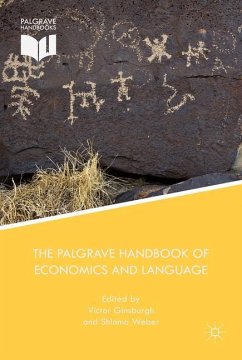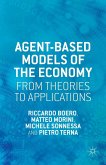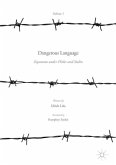The Palgrave Handbook of Economics and Language
Herausgegeben:Ginsburgh, V.; Weber, S.
The Palgrave Handbook of Economics and Language
Herausgegeben:Ginsburgh, V.; Weber, S.
- Gebundenes Buch
- Merkliste
- Auf die Merkliste
- Bewerten Bewerten
- Teilen
- Produkt teilen
- Produkterinnerung
- Produkterinnerung
Do the languages people speak influence their economic decisions and social behavior in multilingual societies? This Handbook brings together scholars from various disciplines to examine the links and tensions between economics and language to find the delicate balance between monetary benefits and psychological costs of linguistic dynamics.
Andere Kunden interessierten sich auch für
![Languages and the First World War: Representation and Memory Languages and the First World War: Representation and Memory]() Languages and the First World War: Representation and Memory38,99 €
Languages and the First World War: Representation and Memory38,99 €![Sign Language in Action Sign Language in Action]() Jemina NapierSign Language in Action75,99 €
Jemina NapierSign Language in Action75,99 €![The Multilingual Edge of Education The Multilingual Edge of Education]() The Multilingual Edge of Education82,99 €
The Multilingual Edge of Education82,99 €![Agent-Based Models of the Economy Agent-Based Models of the Economy]() R. BoeroAgent-Based Models of the Economy97,99 €
R. BoeroAgent-Based Models of the Economy97,99 €![Dangerous Language ¿ Esperanto under Hitler and Stalin Dangerous Language ¿ Esperanto under Hitler and Stalin]() Ulrich LinsDangerous Language ¿ Esperanto under Hitler and Stalin82,99 €
Ulrich LinsDangerous Language ¿ Esperanto under Hitler and Stalin82,99 €![Evolving Agendas in European English-Medium Higher Education Evolving Agendas in European English-Medium Higher Education]() Clive W. EarlsEvolving Agendas in European English-Medium Higher Education75,99 €
Clive W. EarlsEvolving Agendas in European English-Medium Higher Education75,99 €![The Palgrave Handbook of Slavic Languages, Identities and Borders The Palgrave Handbook of Slavic Languages, Identities and Borders]() The Palgrave Handbook of Slavic Languages, Identities and Borders186,99 €
The Palgrave Handbook of Slavic Languages, Identities and Borders186,99 €-
-
-
Do the languages people speak influence their economic decisions and social behavior in multilingual societies? This Handbook brings together scholars from various disciplines to examine the links and tensions between economics and language to find the delicate balance between monetary benefits and psychological costs of linguistic dynamics.
Produktdetails
- Produktdetails
- Verlag: Palgrave Macmillan / Palgrave Macmillan UK / Springer Palgrave Macmillan
- Artikelnr. des Verlages: 978-1-137-32504-4
- 1st ed. 2016
- Seitenzahl: 776
- Erscheinungstermin: 8. Februar 2016
- Englisch
- Abmessung: 241mm x 160mm x 47mm
- Gewicht: 1305g
- ISBN-13: 9781137325044
- ISBN-10: 1137325046
- Artikelnr.: 44372116
- Herstellerkennzeichnung Die Herstellerinformationen sind derzeit nicht verfügbar.
- Verlag: Palgrave Macmillan / Palgrave Macmillan UK / Springer Palgrave Macmillan
- Artikelnr. des Verlages: 978-1-137-32504-4
- 1st ed. 2016
- Seitenzahl: 776
- Erscheinungstermin: 8. Februar 2016
- Englisch
- Abmessung: 241mm x 160mm x 47mm
- Gewicht: 1305g
- ISBN-13: 9781137325044
- ISBN-10: 1137325046
- Artikelnr.: 44372116
- Herstellerkennzeichnung Die Herstellerinformationen sind derzeit nicht verfügbar.
Victor Ginsburgh is Honorary Professor of Economics at the University of Brussels, Belgium. He is an author and editor of numerous books and has published papers in the American Economic Review, Econometrica, Journal of Political Economy, Journal of Economic Perspectives, Journal of Economic Theory, Games and Economic Behavior and other leading journals. His most recent publications include the Handbook of the Economics of Art and Culture (2006 and 2013, co-edited with David Throsby) and How Many Languages Do We Need? (2011, with Shlomo Weber). Shlomo Weber is Robert H. and Nancy Dedman Trustee Professor of Economics at Southern Methodist University, Dallas, Texas, USA, and Academic Head at the Center for the Study of Diversity and Social Interactions, New Economic School, Moscow, Russia. His areas of expertise are game theory, public and political economics. He received various prizes, including the Alexander von Humboldt Research Prize for outstanding foreign scientists and the Megagrant Prize from the Russian Ministry of Science and Education. He recently published The Oxford Handbook of the Russian Economy (2013 in English, and 2014 in Russian, co-edited with Michael Alexeev).
Table of contents
List of Figures
List of Tables
Notes on Contributors
Victor Ginsburgh and Shlomo Weber, Introduction
Part I. Linguistic Diversity: Origins and Measurement
Chapter 1. Nigel Fabb, Linguistic Theory, Linguistic Diversity and Whorfian Economics
1.1 Introduction
1.2 Abstract linguistic form, and the rules and conditions which govern it
1.3 Linguistic diversity: An illustrative comparison between two languages
1.4 Theories of linguistic diversity
1.5 Whorfian psychology and economics: Causal relations between language and thought
1.6 Non-whorfian proposals that language influences thought
1.7 Conclusion
1.8 References
Chapter 2. Andrew Smith, Dynamic Models of Language Evolution. The Linguistic Perpective
2.1 Introduction
2.2 Language diversity
2.3 Language change
2.4 Dynamic models of language
2.5 Conclusion
2.6 References
Chapter 3. Andrew John, Dynamic Models of Language Evolution. The Economic Perspective
3.1 Introduction
3.2 How economic forces can influence language dynamics
3.3 Conclusion
3.4 References
Chapter 4. Mark Leikin, What Do We Learn from Neurolinguistics?
4.1 Introduction
4.2 Terms, definitions and research areas
4.3 Brain and language
4.4 Evolution of brain and language relationships
4.5 Development of brain and language relationships in childhood
4.6 The neurolinguistics of bilingualism
4.7 Conclusions
4.8 References
Chapter 5. Victor Ginsburgh and Shlomo Weber, Linguistic Distances and Ethno-linguistic Fractionalisation and Disenfranchisement Indices
5.1 Introduction
5.2 Languages, dialects and trade languages
5.3 Distances between languages
5.4 The effect of linguistic distances on economic outcomes
5.5 Linguistic distances between groups
5.6 Fractionalization and disenfranchisement indices
5.7 References
Chapter 6. Enrico Spolaore and Romain Wacziarg, Ancestry, Language and Culture
6.1 Introduction
6.2 Ancestry
6.3 Culture
6.4 Ancestry and culture: A simple conceptual framework
6.5 Ancestry and culture: Empirical evidence
6.6 Conclusion
6.7 References
Appendix: Derivations of the results in Section 6.4
Chapter 7. Efthymios Athanasiou, Juan Moreno-Ternero and Shlomo Weber, Language Learning and Communicative Benefits
7.1 Introduction
7.2 Communicative benefits
7.3 Efficiency
7.4 Efficient choices of official languages
7.5 Conclusion
7.6 References
Chapter 8. Niall Bond and Victor Ginsburgh, Language and Emotion
8.1 Introduction
8.2 Emotions and the polyglot
8.3 Choosing languages within language communities
8.4 'Colonized' writers
8.5 Migrating writers
8.6 Between languages: Nabokov, Green and Tabucchi
8.7 'Denying' the language in which they wrote: Kafka and Derrida
8.8 Concluding remarks
Part II. Languages and Markets
Chapter 9. Peter Egger, and Farid Toubal, Common Spoken Languages and International Trade
9.1 Introduction
9.2 Common native and spoken languages on the globe and their measures
9.3 A trade economists stylized view on languages
9.4 Empirical results
9.5 Conclusions
9.6 References
Chapter 10. Nigel Holden, Economic Exchange and Business Language in the Ancient World. An Exploratory Review
10.1 Introduction
10.2 Language considerations
10.3 Context of trade and antiquity
10.4 The written word
10.5 The spoken language of business in the Ancient World
10.6 Commercial terms in various languages of the Ancient World
10.7 The businessman as unsavoury personage in Greek and Latin literature
10.8 Latin: Not just a lingua franca
10.9 Conclusions
10.10 References
Chapter 11. Susanne Tietze, Nigel Hoden and Wilhelm Barner-Rasmussen, Language Use in Multinational Corporations. Towards a Topography of Languages, Special Languages and Corporate Sociolects
11.1 Introduction
11.2 Cities and the MNC
11.3 Research on languageaspects of the MNC: A pragmatic perspective
11.4 Linguascapes, pragmatic spaces and the topography of language
11.5 Discussion
11.6 Conclusion
11.7 References
Chapter 12. Alicia Adsera and Mariola Pyltikova, Language and Migration
12.1 Introduction
12.2 The role of language in migration decisions
12.3 Language proficiency among migrants
12.4 Language and the returns to human capital
12.5 Language and migrants socioeconomic assimilation
12.6 Conclusions
12.7 References
Chapter 13. Johan Heilbron and Gis`ele Sapiro, Translation: Economic and Sociological Perspectives
13.1 Introduction
13.2 International translation flows and the global market of translations
13.3 Political, economic and cultural factors
13.4 Selection, import and reception patterns
13.5 Conclusions
13.6 References
Chapter 14. Dietmar Harhoff, Karin Hoisl, Bruno van Pottelsberghe de la Potterie and Charlotte Vandeput, Languages, Fees and the International Scopeof Patenting
14.1 Introduction
14.2 Institutional background and hypotheses
14.3 Data and econometric modeling
14.4 Empirical implementation and results
14.5 Concluding remarks
14.6 References
Part III. Linguistic Policies and Economic Development
Chapter 15. Klaus Desmet, Ignacio Ortu no-Ort´?n and Romain Wacziarg, Linguistic Cleavages and Economic Development
15.1 Introduction
15.2 A phylogenetic approach to linguistic diversity
15.3 Linguistic diversity, redistribution and economic growth
15.4 Linguistic diversity and economic development
15.5 Conclusion
15.6 References
Chapter 16. Sue Wright, Language Choices: Political and Economic Factors in Three European States
16.1 Introduction
16.2 Nation building
16.3 Language, advantage and group membership
16.4 Conclusion: The role of elites
16.5 References
Chapter 17. Selma Sonntag, Languages, Regional Conflicts and Economic Development in South Asia
17.1 Introduction
17.2 India
17.3 Sri Lanka
17.4 Nepal
17.5 Pakistan
17.6 Conclusion
17.7 References
Chapter 18. Brandon de la Cuesta and Leonard Wantchekon, Is Language Destiny? The Origins and Consequences of Ethnolinguistic Diversity in sub-Saharan Africa
18.1 Introduction
18.2 Why does Africa have such high levels of linguistic diversity?
18.3 The economic and political effects of linguistic diversity
18.4 Conclusion
18.5 References
Chapter 19. Denis Kadochnikov, Languages, Regional Conflicts and Economic Development: Russia
19.1 Introduction
19.2 The standardization of the Russian language in the late medieval Russia (16-17th centuries)
19.3 Language policy in the context of the reforms of Peter the Great and his successors (18th century)
19.4 The role of foreign languages in Russia of the late 18th early 19th centuries
19.5 Language policy in the context of the territorial expansion of the Russian Empire (17-19th centuries)
19.6 Language and politics in the late imperial Russia
19.7 The Socialist Revolution of 1917 and the early Soviet language policy (1920-1930s)
19.8 Late Soviet language policy (1930-1980s)
19.9 Russian and other languages of the Russian Federation in the post-Soviet period
19.10 Summary: socio-economic and political factors and implications of language policy in Russia in historical perspective
19.11 References
Part IV. Globalisation and Minority Languages
Chapter 20. Jacques Melitz, English as a Global Language
20.1 Introduction
20.2 The status of English as a global language
20.3 Areas where English faces sharp limits
20.4 Language learning
20.5 Welfare implications
20.6 References
Chapter 21. François Grin, Challenges of Minority Languages
21.1 Introduction
21.2 What is a minority language?
21.3 The economics of minority language protection and promotion
21.4 Capacity, opportunity and desire: an overview of the basic model
21.5 Conditions for effective policies
21.6 Guidelines for language policy
21.7 The costs and net value of minority language policies
21.8 About contingent and absolute multilingualism
21.9 Concluding remarks
21.10 References
Appendix Minority languages in a strict sense: selected examples
Chapter 22. Bengt-ArneWickstr¨om, Language Rights: A Welfare-economics Approach
22.1 Introduction
22.2 Basic model
22.3 Modifications due to endogenous preferences
22.4 Modifications due to redistribution
22.5 Conclusions
22.6 References
Appendix. Formal analysis
Chapter 23. Jos´e Ram´on Uriarte Ayo, A Game-Theoretic Analysis of Minority Language Use in Multilingual Societies
23.1 Introduction
23.2 Multilingual societies
23.3 The reference point: Linguistic rights, linguistic politeness and expectations
23.4 The maximin language choice
23.5 Information in modern multilingual societies
23.6 The ultimatum language game
23.7 The bilinguals as a player population:The building of linguistic conventions
23.8 Linguistic politeness equilibrium
23.9 Policy suggestions
23.10 Conclusions
23.11 References
Index
List of Figures
List of Tables
Notes on Contributors
Victor Ginsburgh and Shlomo Weber, Introduction
Part I. Linguistic Diversity: Origins and Measurement
Chapter 1. Nigel Fabb, Linguistic Theory, Linguistic Diversity and Whorfian Economics
1.1 Introduction
1.2 Abstract linguistic form, and the rules and conditions which govern it
1.3 Linguistic diversity: An illustrative comparison between two languages
1.4 Theories of linguistic diversity
1.5 Whorfian psychology and economics: Causal relations between language and thought
1.6 Non-whorfian proposals that language influences thought
1.7 Conclusion
1.8 References
Chapter 2. Andrew Smith, Dynamic Models of Language Evolution. The Linguistic Perpective
2.1 Introduction
2.2 Language diversity
2.3 Language change
2.4 Dynamic models of language
2.5 Conclusion
2.6 References
Chapter 3. Andrew John, Dynamic Models of Language Evolution. The Economic Perspective
3.1 Introduction
3.2 How economic forces can influence language dynamics
3.3 Conclusion
3.4 References
Chapter 4. Mark Leikin, What Do We Learn from Neurolinguistics?
4.1 Introduction
4.2 Terms, definitions and research areas
4.3 Brain and language
4.4 Evolution of brain and language relationships
4.5 Development of brain and language relationships in childhood
4.6 The neurolinguistics of bilingualism
4.7 Conclusions
4.8 References
Chapter 5. Victor Ginsburgh and Shlomo Weber, Linguistic Distances and Ethno-linguistic Fractionalisation and Disenfranchisement Indices
5.1 Introduction
5.2 Languages, dialects and trade languages
5.3 Distances between languages
5.4 The effect of linguistic distances on economic outcomes
5.5 Linguistic distances between groups
5.6 Fractionalization and disenfranchisement indices
5.7 References
Chapter 6. Enrico Spolaore and Romain Wacziarg, Ancestry, Language and Culture
6.1 Introduction
6.2 Ancestry
6.3 Culture
6.4 Ancestry and culture: A simple conceptual framework
6.5 Ancestry and culture: Empirical evidence
6.6 Conclusion
6.7 References
Appendix: Derivations of the results in Section 6.4
Chapter 7. Efthymios Athanasiou, Juan Moreno-Ternero and Shlomo Weber, Language Learning and Communicative Benefits
7.1 Introduction
7.2 Communicative benefits
7.3 Efficiency
7.4 Efficient choices of official languages
7.5 Conclusion
7.6 References
Chapter 8. Niall Bond and Victor Ginsburgh, Language and Emotion
8.1 Introduction
8.2 Emotions and the polyglot
8.3 Choosing languages within language communities
8.4 'Colonized' writers
8.5 Migrating writers
8.6 Between languages: Nabokov, Green and Tabucchi
8.7 'Denying' the language in which they wrote: Kafka and Derrida
8.8 Concluding remarks
Part II. Languages and Markets
Chapter 9. Peter Egger, and Farid Toubal, Common Spoken Languages and International Trade
9.1 Introduction
9.2 Common native and spoken languages on the globe and their measures
9.3 A trade economists stylized view on languages
9.4 Empirical results
9.5 Conclusions
9.6 References
Chapter 10. Nigel Holden, Economic Exchange and Business Language in the Ancient World. An Exploratory Review
10.1 Introduction
10.2 Language considerations
10.3 Context of trade and antiquity
10.4 The written word
10.5 The spoken language of business in the Ancient World
10.6 Commercial terms in various languages of the Ancient World
10.7 The businessman as unsavoury personage in Greek and Latin literature
10.8 Latin: Not just a lingua franca
10.9 Conclusions
10.10 References
Chapter 11. Susanne Tietze, Nigel Hoden and Wilhelm Barner-Rasmussen, Language Use in Multinational Corporations. Towards a Topography of Languages, Special Languages and Corporate Sociolects
11.1 Introduction
11.2 Cities and the MNC
11.3 Research on languageaspects of the MNC: A pragmatic perspective
11.4 Linguascapes, pragmatic spaces and the topography of language
11.5 Discussion
11.6 Conclusion
11.7 References
Chapter 12. Alicia Adsera and Mariola Pyltikova, Language and Migration
12.1 Introduction
12.2 The role of language in migration decisions
12.3 Language proficiency among migrants
12.4 Language and the returns to human capital
12.5 Language and migrants socioeconomic assimilation
12.6 Conclusions
12.7 References
Chapter 13. Johan Heilbron and Gis`ele Sapiro, Translation: Economic and Sociological Perspectives
13.1 Introduction
13.2 International translation flows and the global market of translations
13.3 Political, economic and cultural factors
13.4 Selection, import and reception patterns
13.5 Conclusions
13.6 References
Chapter 14. Dietmar Harhoff, Karin Hoisl, Bruno van Pottelsberghe de la Potterie and Charlotte Vandeput, Languages, Fees and the International Scopeof Patenting
14.1 Introduction
14.2 Institutional background and hypotheses
14.3 Data and econometric modeling
14.4 Empirical implementation and results
14.5 Concluding remarks
14.6 References
Part III. Linguistic Policies and Economic Development
Chapter 15. Klaus Desmet, Ignacio Ortu no-Ort´?n and Romain Wacziarg, Linguistic Cleavages and Economic Development
15.1 Introduction
15.2 A phylogenetic approach to linguistic diversity
15.3 Linguistic diversity, redistribution and economic growth
15.4 Linguistic diversity and economic development
15.5 Conclusion
15.6 References
Chapter 16. Sue Wright, Language Choices: Political and Economic Factors in Three European States
16.1 Introduction
16.2 Nation building
16.3 Language, advantage and group membership
16.4 Conclusion: The role of elites
16.5 References
Chapter 17. Selma Sonntag, Languages, Regional Conflicts and Economic Development in South Asia
17.1 Introduction
17.2 India
17.3 Sri Lanka
17.4 Nepal
17.5 Pakistan
17.6 Conclusion
17.7 References
Chapter 18. Brandon de la Cuesta and Leonard Wantchekon, Is Language Destiny? The Origins and Consequences of Ethnolinguistic Diversity in sub-Saharan Africa
18.1 Introduction
18.2 Why does Africa have such high levels of linguistic diversity?
18.3 The economic and political effects of linguistic diversity
18.4 Conclusion
18.5 References
Chapter 19. Denis Kadochnikov, Languages, Regional Conflicts and Economic Development: Russia
19.1 Introduction
19.2 The standardization of the Russian language in the late medieval Russia (16-17th centuries)
19.3 Language policy in the context of the reforms of Peter the Great and his successors (18th century)
19.4 The role of foreign languages in Russia of the late 18th early 19th centuries
19.5 Language policy in the context of the territorial expansion of the Russian Empire (17-19th centuries)
19.6 Language and politics in the late imperial Russia
19.7 The Socialist Revolution of 1917 and the early Soviet language policy (1920-1930s)
19.8 Late Soviet language policy (1930-1980s)
19.9 Russian and other languages of the Russian Federation in the post-Soviet period
19.10 Summary: socio-economic and political factors and implications of language policy in Russia in historical perspective
19.11 References
Part IV. Globalisation and Minority Languages
Chapter 20. Jacques Melitz, English as a Global Language
20.1 Introduction
20.2 The status of English as a global language
20.3 Areas where English faces sharp limits
20.4 Language learning
20.5 Welfare implications
20.6 References
Chapter 21. François Grin, Challenges of Minority Languages
21.1 Introduction
21.2 What is a minority language?
21.3 The economics of minority language protection and promotion
21.4 Capacity, opportunity and desire: an overview of the basic model
21.5 Conditions for effective policies
21.6 Guidelines for language policy
21.7 The costs and net value of minority language policies
21.8 About contingent and absolute multilingualism
21.9 Concluding remarks
21.10 References
Appendix Minority languages in a strict sense: selected examples
Chapter 22. Bengt-ArneWickstr¨om, Language Rights: A Welfare-economics Approach
22.1 Introduction
22.2 Basic model
22.3 Modifications due to endogenous preferences
22.4 Modifications due to redistribution
22.5 Conclusions
22.6 References
Appendix. Formal analysis
Chapter 23. Jos´e Ram´on Uriarte Ayo, A Game-Theoretic Analysis of Minority Language Use in Multilingual Societies
23.1 Introduction
23.2 Multilingual societies
23.3 The reference point: Linguistic rights, linguistic politeness and expectations
23.4 The maximin language choice
23.5 Information in modern multilingual societies
23.6 The ultimatum language game
23.7 The bilinguals as a player population:The building of linguistic conventions
23.8 Linguistic politeness equilibrium
23.9 Policy suggestions
23.10 Conclusions
23.11 References
Index
Table of contents
List of Figures
List of Tables
Notes on Contributors
Victor Ginsburgh and Shlomo Weber, Introduction
Part I. Linguistic Diversity: Origins and Measurement
Chapter 1. Nigel Fabb, Linguistic Theory, Linguistic Diversity and Whorfian Economics
1.1 Introduction
1.2 Abstract linguistic form, and the rules and conditions which govern it
1.3 Linguistic diversity: An illustrative comparison between two languages
1.4 Theories of linguistic diversity
1.5 Whorfian psychology and economics: Causal relations between language and thought
1.6 Non-whorfian proposals that language influences thought
1.7 Conclusion
1.8 References
Chapter 2. Andrew Smith, Dynamic Models of Language Evolution. The Linguistic Perpective
2.1 Introduction
2.2 Language diversity
2.3 Language change
2.4 Dynamic models of language
2.5 Conclusion
2.6 References
Chapter 3. Andrew John, Dynamic Models of Language Evolution. The Economic Perspective
3.1 Introduction
3.2 How economic forces can influence language dynamics
3.3 Conclusion
3.4 References
Chapter 4. Mark Leikin, What Do We Learn from Neurolinguistics?
4.1 Introduction
4.2 Terms, definitions and research areas
4.3 Brain and language
4.4 Evolution of brain and language relationships
4.5 Development of brain and language relationships in childhood
4.6 The neurolinguistics of bilingualism
4.7 Conclusions
4.8 References
Chapter 5. Victor Ginsburgh and Shlomo Weber, Linguistic Distances and Ethno-linguistic Fractionalisation and Disenfranchisement Indices
5.1 Introduction
5.2 Languages, dialects and trade languages
5.3 Distances between languages
5.4 The effect of linguistic distances on economic outcomes
5.5 Linguistic distances between groups
5.6 Fractionalization and disenfranchisement indices
5.7 References
Chapter 6. Enrico Spolaore and Romain Wacziarg, Ancestry, Language and Culture
6.1 Introduction
6.2 Ancestry
6.3 Culture
6.4 Ancestry and culture: A simple conceptual framework
6.5 Ancestry and culture: Empirical evidence
6.6 Conclusion
6.7 References
Appendix: Derivations of the results in Section 6.4
Chapter 7. Efthymios Athanasiou, Juan Moreno-Ternero and Shlomo Weber, Language Learning and Communicative Benefits
7.1 Introduction
7.2 Communicative benefits
7.3 Efficiency
7.4 Efficient choices of official languages
7.5 Conclusion
7.6 References
Chapter 8. Niall Bond and Victor Ginsburgh, Language and Emotion
8.1 Introduction
8.2 Emotions and the polyglot
8.3 Choosing languages within language communities
8.4 'Colonized' writers
8.5 Migrating writers
8.6 Between languages: Nabokov, Green and Tabucchi
8.7 'Denying' the language in which they wrote: Kafka and Derrida
8.8 Concluding remarks
Part II. Languages and Markets
Chapter 9. Peter Egger, and Farid Toubal, Common Spoken Languages and International Trade
9.1 Introduction
9.2 Common native and spoken languages on the globe and their measures
9.3 A trade economists stylized view on languages
9.4 Empirical results
9.5 Conclusions
9.6 References
Chapter 10. Nigel Holden, Economic Exchange and Business Language in the Ancient World. An Exploratory Review
10.1 Introduction
10.2 Language considerations
10.3 Context of trade and antiquity
10.4 The written word
10.5 The spoken language of business in the Ancient World
10.6 Commercial terms in various languages of the Ancient World
10.7 The businessman as unsavoury personage in Greek and Latin literature
10.8 Latin: Not just a lingua franca
10.9 Conclusions
10.10 References
Chapter 11. Susanne Tietze, Nigel Hoden and Wilhelm Barner-Rasmussen, Language Use in Multinational Corporations. Towards a Topography of Languages, Special Languages and Corporate Sociolects
11.1 Introduction
11.2 Cities and the MNC
11.3 Research on languageaspects of the MNC: A pragmatic perspective
11.4 Linguascapes, pragmatic spaces and the topography of language
11.5 Discussion
11.6 Conclusion
11.7 References
Chapter 12. Alicia Adsera and Mariola Pyltikova, Language and Migration
12.1 Introduction
12.2 The role of language in migration decisions
12.3 Language proficiency among migrants
12.4 Language and the returns to human capital
12.5 Language and migrants socioeconomic assimilation
12.6 Conclusions
12.7 References
Chapter 13. Johan Heilbron and Gis`ele Sapiro, Translation: Economic and Sociological Perspectives
13.1 Introduction
13.2 International translation flows and the global market of translations
13.3 Political, economic and cultural factors
13.4 Selection, import and reception patterns
13.5 Conclusions
13.6 References
Chapter 14. Dietmar Harhoff, Karin Hoisl, Bruno van Pottelsberghe de la Potterie and Charlotte Vandeput, Languages, Fees and the International Scopeof Patenting
14.1 Introduction
14.2 Institutional background and hypotheses
14.3 Data and econometric modeling
14.4 Empirical implementation and results
14.5 Concluding remarks
14.6 References
Part III. Linguistic Policies and Economic Development
Chapter 15. Klaus Desmet, Ignacio Ortu no-Ort´?n and Romain Wacziarg, Linguistic Cleavages and Economic Development
15.1 Introduction
15.2 A phylogenetic approach to linguistic diversity
15.3 Linguistic diversity, redistribution and economic growth
15.4 Linguistic diversity and economic development
15.5 Conclusion
15.6 References
Chapter 16. Sue Wright, Language Choices: Political and Economic Factors in Three European States
16.1 Introduction
16.2 Nation building
16.3 Language, advantage and group membership
16.4 Conclusion: The role of elites
16.5 References
Chapter 17. Selma Sonntag, Languages, Regional Conflicts and Economic Development in South Asia
17.1 Introduction
17.2 India
17.3 Sri Lanka
17.4 Nepal
17.5 Pakistan
17.6 Conclusion
17.7 References
Chapter 18. Brandon de la Cuesta and Leonard Wantchekon, Is Language Destiny? The Origins and Consequences of Ethnolinguistic Diversity in sub-Saharan Africa
18.1 Introduction
18.2 Why does Africa have such high levels of linguistic diversity?
18.3 The economic and political effects of linguistic diversity
18.4 Conclusion
18.5 References
Chapter 19. Denis Kadochnikov, Languages, Regional Conflicts and Economic Development: Russia
19.1 Introduction
19.2 The standardization of the Russian language in the late medieval Russia (16-17th centuries)
19.3 Language policy in the context of the reforms of Peter the Great and his successors (18th century)
19.4 The role of foreign languages in Russia of the late 18th early 19th centuries
19.5 Language policy in the context of the territorial expansion of the Russian Empire (17-19th centuries)
19.6 Language and politics in the late imperial Russia
19.7 The Socialist Revolution of 1917 and the early Soviet language policy (1920-1930s)
19.8 Late Soviet language policy (1930-1980s)
19.9 Russian and other languages of the Russian Federation in the post-Soviet period
19.10 Summary: socio-economic and political factors and implications of language policy in Russia in historical perspective
19.11 References
Part IV. Globalisation and Minority Languages
Chapter 20. Jacques Melitz, English as a Global Language
20.1 Introduction
20.2 The status of English as a global language
20.3 Areas where English faces sharp limits
20.4 Language learning
20.5 Welfare implications
20.6 References
Chapter 21. François Grin, Challenges of Minority Languages
21.1 Introduction
21.2 What is a minority language?
21.3 The economics of minority language protection and promotion
21.4 Capacity, opportunity and desire: an overview of the basic model
21.5 Conditions for effective policies
21.6 Guidelines for language policy
21.7 The costs and net value of minority language policies
21.8 About contingent and absolute multilingualism
21.9 Concluding remarks
21.10 References
Appendix Minority languages in a strict sense: selected examples
Chapter 22. Bengt-ArneWickstr¨om, Language Rights: A Welfare-economics Approach
22.1 Introduction
22.2 Basic model
22.3 Modifications due to endogenous preferences
22.4 Modifications due to redistribution
22.5 Conclusions
22.6 References
Appendix. Formal analysis
Chapter 23. Jos´e Ram´on Uriarte Ayo, A Game-Theoretic Analysis of Minority Language Use in Multilingual Societies
23.1 Introduction
23.2 Multilingual societies
23.3 The reference point: Linguistic rights, linguistic politeness and expectations
23.4 The maximin language choice
23.5 Information in modern multilingual societies
23.6 The ultimatum language game
23.7 The bilinguals as a player population:The building of linguistic conventions
23.8 Linguistic politeness equilibrium
23.9 Policy suggestions
23.10 Conclusions
23.11 References
Index
List of Figures
List of Tables
Notes on Contributors
Victor Ginsburgh and Shlomo Weber, Introduction
Part I. Linguistic Diversity: Origins and Measurement
Chapter 1. Nigel Fabb, Linguistic Theory, Linguistic Diversity and Whorfian Economics
1.1 Introduction
1.2 Abstract linguistic form, and the rules and conditions which govern it
1.3 Linguistic diversity: An illustrative comparison between two languages
1.4 Theories of linguistic diversity
1.5 Whorfian psychology and economics: Causal relations between language and thought
1.6 Non-whorfian proposals that language influences thought
1.7 Conclusion
1.8 References
Chapter 2. Andrew Smith, Dynamic Models of Language Evolution. The Linguistic Perpective
2.1 Introduction
2.2 Language diversity
2.3 Language change
2.4 Dynamic models of language
2.5 Conclusion
2.6 References
Chapter 3. Andrew John, Dynamic Models of Language Evolution. The Economic Perspective
3.1 Introduction
3.2 How economic forces can influence language dynamics
3.3 Conclusion
3.4 References
Chapter 4. Mark Leikin, What Do We Learn from Neurolinguistics?
4.1 Introduction
4.2 Terms, definitions and research areas
4.3 Brain and language
4.4 Evolution of brain and language relationships
4.5 Development of brain and language relationships in childhood
4.6 The neurolinguistics of bilingualism
4.7 Conclusions
4.8 References
Chapter 5. Victor Ginsburgh and Shlomo Weber, Linguistic Distances and Ethno-linguistic Fractionalisation and Disenfranchisement Indices
5.1 Introduction
5.2 Languages, dialects and trade languages
5.3 Distances between languages
5.4 The effect of linguistic distances on economic outcomes
5.5 Linguistic distances between groups
5.6 Fractionalization and disenfranchisement indices
5.7 References
Chapter 6. Enrico Spolaore and Romain Wacziarg, Ancestry, Language and Culture
6.1 Introduction
6.2 Ancestry
6.3 Culture
6.4 Ancestry and culture: A simple conceptual framework
6.5 Ancestry and culture: Empirical evidence
6.6 Conclusion
6.7 References
Appendix: Derivations of the results in Section 6.4
Chapter 7. Efthymios Athanasiou, Juan Moreno-Ternero and Shlomo Weber, Language Learning and Communicative Benefits
7.1 Introduction
7.2 Communicative benefits
7.3 Efficiency
7.4 Efficient choices of official languages
7.5 Conclusion
7.6 References
Chapter 8. Niall Bond and Victor Ginsburgh, Language and Emotion
8.1 Introduction
8.2 Emotions and the polyglot
8.3 Choosing languages within language communities
8.4 'Colonized' writers
8.5 Migrating writers
8.6 Between languages: Nabokov, Green and Tabucchi
8.7 'Denying' the language in which they wrote: Kafka and Derrida
8.8 Concluding remarks
Part II. Languages and Markets
Chapter 9. Peter Egger, and Farid Toubal, Common Spoken Languages and International Trade
9.1 Introduction
9.2 Common native and spoken languages on the globe and their measures
9.3 A trade economists stylized view on languages
9.4 Empirical results
9.5 Conclusions
9.6 References
Chapter 10. Nigel Holden, Economic Exchange and Business Language in the Ancient World. An Exploratory Review
10.1 Introduction
10.2 Language considerations
10.3 Context of trade and antiquity
10.4 The written word
10.5 The spoken language of business in the Ancient World
10.6 Commercial terms in various languages of the Ancient World
10.7 The businessman as unsavoury personage in Greek and Latin literature
10.8 Latin: Not just a lingua franca
10.9 Conclusions
10.10 References
Chapter 11. Susanne Tietze, Nigel Hoden and Wilhelm Barner-Rasmussen, Language Use in Multinational Corporations. Towards a Topography of Languages, Special Languages and Corporate Sociolects
11.1 Introduction
11.2 Cities and the MNC
11.3 Research on languageaspects of the MNC: A pragmatic perspective
11.4 Linguascapes, pragmatic spaces and the topography of language
11.5 Discussion
11.6 Conclusion
11.7 References
Chapter 12. Alicia Adsera and Mariola Pyltikova, Language and Migration
12.1 Introduction
12.2 The role of language in migration decisions
12.3 Language proficiency among migrants
12.4 Language and the returns to human capital
12.5 Language and migrants socioeconomic assimilation
12.6 Conclusions
12.7 References
Chapter 13. Johan Heilbron and Gis`ele Sapiro, Translation: Economic and Sociological Perspectives
13.1 Introduction
13.2 International translation flows and the global market of translations
13.3 Political, economic and cultural factors
13.4 Selection, import and reception patterns
13.5 Conclusions
13.6 References
Chapter 14. Dietmar Harhoff, Karin Hoisl, Bruno van Pottelsberghe de la Potterie and Charlotte Vandeput, Languages, Fees and the International Scopeof Patenting
14.1 Introduction
14.2 Institutional background and hypotheses
14.3 Data and econometric modeling
14.4 Empirical implementation and results
14.5 Concluding remarks
14.6 References
Part III. Linguistic Policies and Economic Development
Chapter 15. Klaus Desmet, Ignacio Ortu no-Ort´?n and Romain Wacziarg, Linguistic Cleavages and Economic Development
15.1 Introduction
15.2 A phylogenetic approach to linguistic diversity
15.3 Linguistic diversity, redistribution and economic growth
15.4 Linguistic diversity and economic development
15.5 Conclusion
15.6 References
Chapter 16. Sue Wright, Language Choices: Political and Economic Factors in Three European States
16.1 Introduction
16.2 Nation building
16.3 Language, advantage and group membership
16.4 Conclusion: The role of elites
16.5 References
Chapter 17. Selma Sonntag, Languages, Regional Conflicts and Economic Development in South Asia
17.1 Introduction
17.2 India
17.3 Sri Lanka
17.4 Nepal
17.5 Pakistan
17.6 Conclusion
17.7 References
Chapter 18. Brandon de la Cuesta and Leonard Wantchekon, Is Language Destiny? The Origins and Consequences of Ethnolinguistic Diversity in sub-Saharan Africa
18.1 Introduction
18.2 Why does Africa have such high levels of linguistic diversity?
18.3 The economic and political effects of linguistic diversity
18.4 Conclusion
18.5 References
Chapter 19. Denis Kadochnikov, Languages, Regional Conflicts and Economic Development: Russia
19.1 Introduction
19.2 The standardization of the Russian language in the late medieval Russia (16-17th centuries)
19.3 Language policy in the context of the reforms of Peter the Great and his successors (18th century)
19.4 The role of foreign languages in Russia of the late 18th early 19th centuries
19.5 Language policy in the context of the territorial expansion of the Russian Empire (17-19th centuries)
19.6 Language and politics in the late imperial Russia
19.7 The Socialist Revolution of 1917 and the early Soviet language policy (1920-1930s)
19.8 Late Soviet language policy (1930-1980s)
19.9 Russian and other languages of the Russian Federation in the post-Soviet period
19.10 Summary: socio-economic and political factors and implications of language policy in Russia in historical perspective
19.11 References
Part IV. Globalisation and Minority Languages
Chapter 20. Jacques Melitz, English as a Global Language
20.1 Introduction
20.2 The status of English as a global language
20.3 Areas where English faces sharp limits
20.4 Language learning
20.5 Welfare implications
20.6 References
Chapter 21. François Grin, Challenges of Minority Languages
21.1 Introduction
21.2 What is a minority language?
21.3 The economics of minority language protection and promotion
21.4 Capacity, opportunity and desire: an overview of the basic model
21.5 Conditions for effective policies
21.6 Guidelines for language policy
21.7 The costs and net value of minority language policies
21.8 About contingent and absolute multilingualism
21.9 Concluding remarks
21.10 References
Appendix Minority languages in a strict sense: selected examples
Chapter 22. Bengt-ArneWickstr¨om, Language Rights: A Welfare-economics Approach
22.1 Introduction
22.2 Basic model
22.3 Modifications due to endogenous preferences
22.4 Modifications due to redistribution
22.5 Conclusions
22.6 References
Appendix. Formal analysis
Chapter 23. Jos´e Ram´on Uriarte Ayo, A Game-Theoretic Analysis of Minority Language Use in Multilingual Societies
23.1 Introduction
23.2 Multilingual societies
23.3 The reference point: Linguistic rights, linguistic politeness and expectations
23.4 The maximin language choice
23.5 Information in modern multilingual societies
23.6 The ultimatum language game
23.7 The bilinguals as a player population:The building of linguistic conventions
23.8 Linguistic politeness equilibrium
23.9 Policy suggestions
23.10 Conclusions
23.11 References
Index
"This volume is clearly an important contribution to the literature on the economics of language. It is comprehensive: the topics cover the full range of issues that we would want to see addressed. ... While few will want to read it from cover to cover, those with even a passing interest in the nexus of language and economics, regardless of their own discipline, will find individual chapters invaluable." (Barry R. Chiswick, Journal of Economic Literature, Vol. 54 (3), September, 2016)








